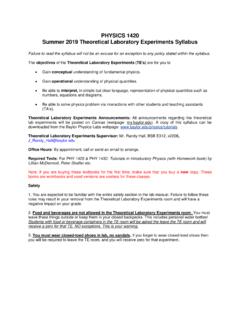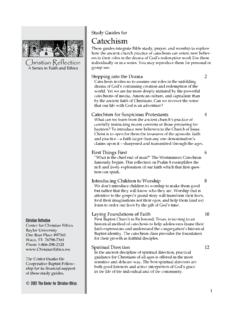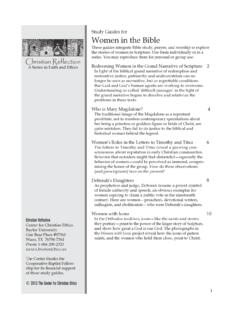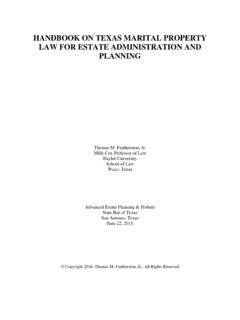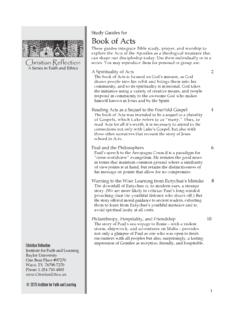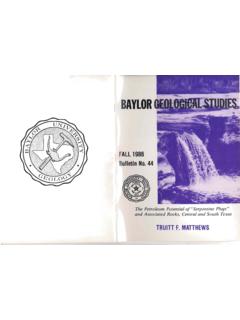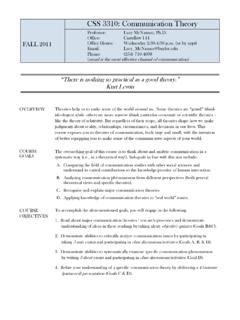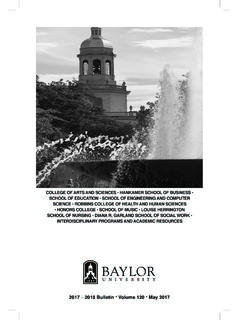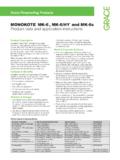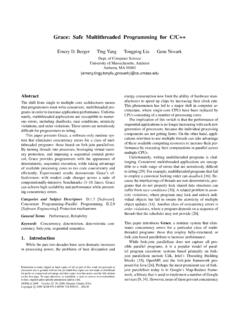Transcription of God’s Enabling Grace - baylor.edu
1 2 God s Enabling GraceThe Sermon on the Mount seems filled with stringent laws and calls for us to pull ourselves up by our own bootstraps. Where is God s Enabling Grace ? The Sermon offers Jesus sayings as verbal icons through which we may see into God s will and be empowered for the moral Reading: Matthew 6:25-34 Meditation Many in our culture (Christians and non-Christians) think of the Sermon on the Mount as high ideals or hard teachings. They admire it from a [Yet] the Christian life is not just hard human effort to live up to high ideals; nor is it just a bunch of duties. It is about God s Grace . It is about living in the presence of God. It is the invitation of Jesus to participate in the new things God is doing all the H.
2 StassenReflectionWhy does the Sermon on the Mount seem like bad news to many people today? Why don t we respond with delighted enthusiasm like the astounded listeners who followed Jesus down from the mountain in Galilee, believing his teaching was authoritative and liberating good news for their lives (Matthew 7:28ff.)? Our dour reaction, Charles Talbert suggests, comes from misinterpreting the Sermon as a list of divine rules to obey in order to gain God s love (this is the approach of legalism) or as demands we must follow out of gratitude if we are to remain in relation with God (this is covenantal nomism). Either way, we distort Jesus teaching into very bad news indeed into an unnerving call to scale moral peaks that are too high for anyone to we should read the Sermon (and all of Matthew s Gos-pel) from the perspective of new covenant piety the view that God graciously enters into a relation with humans [and].
3 Gives guid- ance about what pleases and displeases him, Talbert says. When humans follow that guidance, it is because God graciously enables their obedience. Yes, the Sermon depicts a high ideal of disciple-ship, but it also promises that God will empower us to follow it faithfully. So why do we overlook this last part? We easily read Paul s and John s writings from the perspective of new covenant piety because they describe God s Enabling Grace in terms of spiritual indwelling. Since the Spirit of God dwells in [and] the Spirit of him who raised Jesus from the dead dwells in you (Romans 8:9-11), Paul can urge disciples to work out your own it is God who is at work in you, Enabling you both to will and to work for his good pleasure (Philippians 2:12b-13).
4 In a familiar Johannine text Jesus speaks of mutual indwelling: Abide in me as I abide in you. Just as the branch cannot bear fruit by itself unless it abides in the vine, neither can you unless you abide in me. I am the vine, you are the branches. Those who abide in me and I in them bear much fruit, because apart from me you can do What do you think?Was this study guide useful for your personal or group study? Please send your suggestions to ReflectionCenter for Christian EthicsBaylor UniversityOne Bear Place #97361 Waco, TX 76798-7361 Phone 1-866-298-2325 2008 The Center for Christian EthicsFocus Article: Grace in the Sermon on the Mount(Sermon on the Mount, pp.)
5 11-18)Christian ReflectionA Series in Faith and My Father is glorified by this, that you bear much fruit and become my disciples (John 15:4-5). The First Gospel, however, does not use the language of spiri- tual indwelling. It expresses new covenant piety in another way: the divine transformation that enables faithful discipleship comes through a vision of the deity. Human hearts become tuned to follow Jesus when they are in his divine presence. Being with Jesus is to be transformed by that vision that enables the conquest of evil passions and the acquisition of virtue, says Talbert. Matthew wants readers to see Jesus and be transformed. The sayings of Jesus in the Sermon function as verbal icons (windows into God s world) that enable readers to see into God s uncondi-tioned will.
6 This vision of the divine transforms our character by Enabling us to see reality differently. Once we see reality differently, our dispositions, intentions, and motivations also change. Study Questions1. Discuss the differences among legalism, covenantal nomism, and new covenant piety three views of the relation between God s Grace and human moral action. How would each view shape the way one hears the Sermon on the Mount?2. Describe the transformation by vision model of God s Enabling Grace . How do Paul and John ( , in 2 Corinthians 3:18 and 1 John 3:6) occasionally use this model? 3. How does Matthew deploy the transformation by vision model his description of Jesus ministry (4:12-22) before the Sermon on the Mount?
7 4. What does Charles Talbert mean by a verbal icon ? Review a major section of the Sermon , the Beatitudes (Matthew 5:3-12), the so-called antitheses (5:21-48), the teachings about giving alms, praying, and fasting (6:1-18), or the teachings on trust in God (6:25-34) and discuss how it might function as a verbal Hymn: Sitting at the Feet of Jesus (vv. 1a, 2d, 3)Sitting at the feet of Jesus,oh, what words we hear him say!While we from his fullness gathergrace and comfort every we have the mind of Jesusand be holy as he is;may we prove we ve been with Jesus,who is all our us, O our Savior, bless us,as we sit low at your , look down in love upon us;let us see your face so H.
8 (19th Century), Tunes: HERE IS LOVE or PLEADING SAVIOR Glen H. Stassen, Living the Sermon on the Mount: A Practical Hope for Grace and Deliverance (San Francisco, CA: Jossey-Bass, 2006), ReflectionA Series in Faith and EthicsRobert B. Kruschwitz, the author of this study guide, directs the Center for Christian Ethics at baylor University. He serves as General Editor of Christian Reflection. 2008 The Center for Christian Ethics15 God s Enabling GraceLesson PlansTeaching Goals1. To distinguish among legalism, covenantal nomism, and new covenant piety three views of the relation between God and human To understand the concept of a verbal To hear the good news in the Sermon on the Mount (and the Gospel of Matthew generally) from the perspective of new covenant the Group MeetingDistribute copies of the study guide on pp.
9 2-3 and ask members to read the Bible passages in the guide. Dis- tribute copies of Sermon on the Mount (Christian Reflection) and ask members to read the focus article before the group meeting. For the departing hymn Sitting at the Feet of Jesus locate one of the familiar tunes HERE IS LOVE or PLEADING SAVIOR in your church s hymnal or on the Web at with a Story The more morally earnest among us may hear [in the Sermon on the Mount]..a judgmental tone as the imperatives come at us like one-two punches to the gut, writes Richard Ward. The Sermon s high-minded moral code seems out of reach way up on the pantry shelf that is nearest to heaven. This verse certainly does not help: Be perfect, therefore, as your heavenly Father is perfect (Matthew 5:48).
10 The whole listening project may shut down right there. A high school friend of mine was an earnest young man, but his adolescent faith rested on a literal interpretation of the Bible. When he came to this verse, bereft of the benefit of critical studies, he threw up his hands and walked away from the Christian faith altogether! (The Sermon on the Mount, 31-32).Let s be honest. What do we hear in the Sermon on the Mount impossible moral demands or an invitation to live in a new way in God s kingdom through God s Enabling Grace ?PrayerInvite members to share their personal celebrations and concerns with the group. Provide time for each person to pray silently. Conclude by asking God to tune our ears to hear and our hearts to sing God s ReadingAsk a group member to read Matthew 6:25-34 from a modern members to reflect on the meditation during a period of Let this discussion set the stage for your study of the Sermon on the Mount by clearing away a common mis-conception about the Sermon (and the First Gospel generally).
